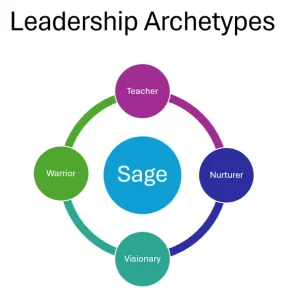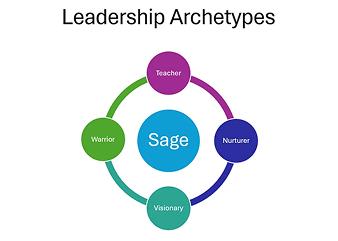Leadership Archetypes
Every leader will progress through each of these archetypes on their leadership journey. There are five leadership archetypes all leaders will go through. I have experienced them all and feel when we have learned the lessons for each archetype, we progress onto the next archetype. These archetypes are based on the ones detailed in the Leadership Wheel by Clinton C. Sidle. In this book, it describes each archetype and the characteristics and traits that we learn, display and teach to others. As leaders, we are role models. We are continuously learning and applying these learnings – in our everyday lives as well as our professional lives. The Leadership wheel stands above in its comprehensiveness because it is based on simple, universal truths.
The leadership wheel outlines that the qualities which promote learning and development; are the same qualities contributing to effective leadership. The leadership wheel provides a robust framework to support learning and growth as a model for leadership development. Leaders are teachers. Leadership is learned through experience. It is a continuous learning learning experience. All great leaders are lifelong learners. They know they can learn from other people, places, experiences and situations. They are also great teachers. The leadership wheel offers fresh and powerful insights into how learning and development occurs. The factors for learning are the same as those for leading. The process of learning models the desired result.
The qualities that promote learning and development are the same qualities that contribute to effective leadership. Each direction, or archetype of the leadership wheel captures a key aspect of learning, as well as a key aspect of what makes a good leader. Without all these aspects, we cannot learn, which means we cannot lead effectively. As leaders, learning is in essence the five different ways of being. As leaders, we are learners and in the learning process, we will progress through the following five stages to reach the final stage where we are then able to impart our knowledge and experience to others. The five stages are:
- Teacher
- Nurturer
- Visionary
- Warrior
- Sage
A summary of each of the leadership archetypes are provided below:
The Teacher – Knowing the world
Leaders know their stuff as well as the world. Effective leaders consciously participate in a process of acquiring and applying their knowledge and expertise needed to master the situation and the context. These leaders are self-directed in their learning. They acquire the skills and competencies required for meeting their goals. They seek to concrete and share their knowledge with others.
The Nurturer – Awakening the heart
Effective leaders also know and learn through what gives them heart. They have an appreciation of their own basic goodness and what they have to offer to other people. Empathetic and values driven, it enables these leaders to engage others in ways to build solid relationships. These leaders are effective team players, responsible stewards, and good citizens. These leaders are motivated by learning an growth for everyone.
The Visionary – Seeing the Way
These leaders are driven by a purpose and a constant seeking of the highest view to serve. They are able to step back, take a larger view, and identify what is most important. The visionary has a sense of purpose that integrates life, gives meaning to experience and drives learning and development. Most importantly, this purpose serves to align them with their calling and draw them to work that carries meaning that is simply beyond serving themselves. They see leadership is a result, not a calling.
The Warrior – Embodying the way
All great leaders learn to be the change they want to see in the world. These leaders have an authenticity that comes from learning to close the gap between knowing and doing. The warrior deploys themselves in ways that match word and deed. These leaders knw who they are, what is important to them, and how to act it out in the world. This drives their learning process, gives them integrity. This is what makes them authentic, real, and powerful for others. The warrior knows what they want and will experiment, risk and perserver to bring it about. This gives them the power to achieve extraordinary results.
The Sage – Learning to learn
This is the most essential characteristic of a leader. This is the origin from which all the other leadership archetypes develop. The awareness of the sage taps into the powers of the other archetypes and leads to a balanced development of the self. Great leaders know how to learn and this ability generates a sense of optimism and a feeling of being empowered to take charge of life and circumstances. The sage is proactive and gets the most out of experience. The sage seizes opportunities and turns adversity into meaning-making experiences. The sage feel like the master of their lives and circumstances rather than victims. This subtle difference in attitude is one that makes the greatest difference in results.
To sustain energy for the effort, the key is lighting the fire. This is the way of the Sage. When we awaken the desire to learn and become truly human, it starts with asking “Who am I and what is my medicine?”. When we address the meaning of this question, we tap into the energy necessary for personal development. As humans, we are free to create and choose our world, to choose values, direction and meaning for life and impose it upon ourselves. This is what Friedrich Nietzche called “self-overcoming”. We often need to “Get out of our own way!”. When we hook the energy of becoming and create uplifting, fulfilling and exhilarating energy. Outward bound and intense group learning experiences in leadership development are so powerful. People are challenged with their self-imposed limitations and provided an opportunity to overcome them. When people break through, the result is invigorating.
So, who are you becoming?

Reference:
The Leadership Wheel, Five steps for achieving individual and organisational greatness – C.Clinton Sidle, 2005


